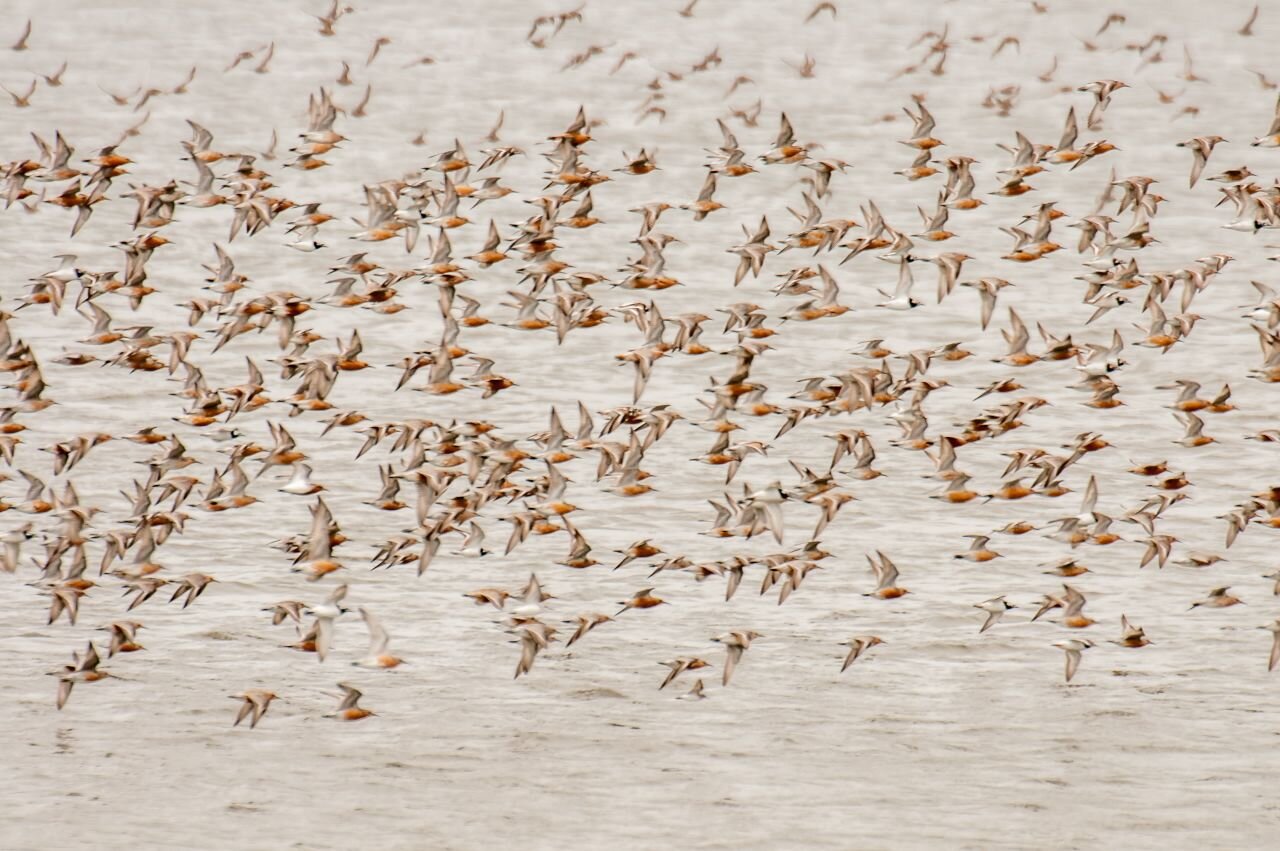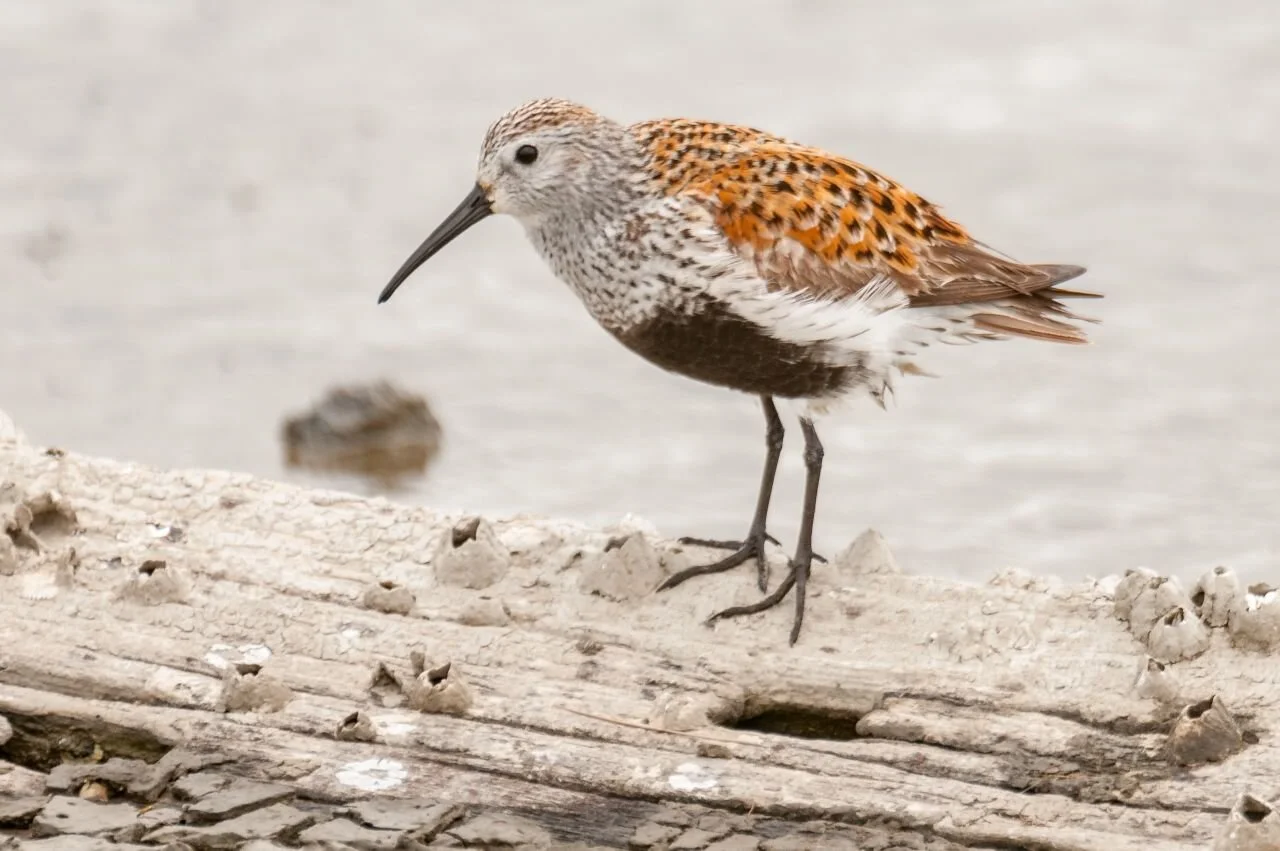A mixed flock, mostly Red Knots
In this time of pandemic with its social distancing and self-isolating, we’ve experienced a change in birding as well. There is more backyard birding, local-park birding and an absence of long-distance-trip birding. Festivals and major annual birding events such as “The World Series of Birding” in New Jersey and “The Biggest Week in Birding” at Magee Marsh in Ohio have either been cancelled or completely reconfigured to accommodate strictly local small group socially distanced birding, and many regular springtime organized migration excursions by trip companies to such hot spots as the Dry Tortugas, High Island in Texas, and any number of popular springtime birding spots have been postponed until next year.
Needless to say, this has affected Jewel and me as well. Most every year when we return to Pennsylvania from our winter in warm and sunny Florida we have taken May migration birding trips to Cape May, New Jersey and/or Magee Marsh in Ohio. In June, for each of the past five years we have taken week-long birding trips to Maine. Some years, we have done all three of these exciting trips and they have provided many experiences, material and photographs for any number of these columns in past years. As we are not leaving our Pennsylvania farm for any birding trips this spring, perhaps a virtual birding tour through my past archives will provide material and photos to recreate a Cape May, New Jersey birding trip for this month’s column. Here are a number of never-before-seen-or used photos from past years in the spring in Cape May.
While Cape May is an excellent place to see migrating warblers, in my humble opinion Magee Marsh provides better views, up close and personal, of warblers; whereas, Cape May is completely unsurpassed in providing views of migrating waders and shorebirds. Thousands of migrating shorebirds time their northbound migration to reach Cape May’s Delaware Bay beaches just as horseshoe crabs are coming ashore to lay their eggs. When they all rise up to fly to a different beach location their flight is spectacular. (top) I have many different species in huge flocks flying, but chose Red Knots to illustrate this common scene. I counted 22 Ruddy Turnstones, two Sanderlings and one unidentified peep in this flight photo of Red Knots. How many can you find?
Warblers are readily found almost anywhere on the Cape May end of New Jersey, including at bird baths in town, such as this female American Redstart, (photo 2) and just about any species can suddenly appear almost anywhere, unsuspected and confiding, such as this Yellow-billed Cuckoo. (photo 3)
Along the roads through the marshes to various well known birding beaches such as Reed’s Beach, Moore’s Beach, Heislerville, Fortescue and several lesser known access points, Marsh Wrens (photo 4) sing incessantly, and often hard to find less common sparrows like the Seaside Sparrow (photo 5) pop up into view. Along gullies through the marshes Black Ducks with their yellowish-green bills and dark purple, bordered in black, wing speculum afford excellent opportunities to compare how they differ from their Mallard and Mottled cousins. (photo 6)
Upon arrival at the bay beaches one cannot help but admire the large number of various species of gulls in breeding plumage. Laughing Gulls with their jet black heads, surrounding a very regal looking Herring Gull with its bright yellow eye ringed in red, and bright red beak tip, look very different from the drab plumaged Laughing and Herring Gulls we observe all winter in Florida. (photo 7)
A Willet foraging for food along a tide line in breeding plumage almost looks like a different species from the very plain individuals we are accustomed to seeing in Florida (photo 8), but the biggest shock for a Florida birder comes upon seeing his/her first breeding plumage Black-bellied Plover (photo 9) or Dunlin. (photo 10) The Cape May Black-bellied Plover makes the species’ name completely understandable; and the former Dunlin name of Red-backed Sandpiper now seems quite appropriate. While both of these species are common and readily found in Florida in the winter, they never at that time have this wonderful coloration that makes both species so striking.
Having opened the column with flying Red Knots, I will now close with Red Knots. (photo 11) In Florida in the winter there are only a few straggler Red Knots to be found as the vast majority of the species migrate all the way to the southern tip of South America in one of the longest migration patterns of any species. Those few have virtually no red and the bird depicted on the left here shows the very early change from the winter plumage into the beautiful color the bird on the right sports as they continue their northbound migration. Note the black lines in the sand where horseshoe crab eggs have been deposited by the tides providing the energy rich food all the species need to fuel their various migration flights and breeding purposes.
Perhaps someday in the distant future we will all look back on these times and say, “Remember that spring (summer, fall, winter or whatever) of 2020 when we were all cooped up because of that coronavirus?” Perhaps all this will just be a blip in our long life lines. Then again, maybe it will be a truly life-changing time. Is it possible that virtual birding will become the birding technique of the future? Can you imagine birding right from your living room couch instead of having to go out in the field? I have always said, “You can’t find birds sitting on your couch!” But maybe that won’t be true anymore. Still, there is one huge problem: how do we get birds to get on a Zoom app and do their part to participate?
For more on Red Knots, see: https://www.stlucieaudubon.org/hart-beat/2019/10/1/hart-beat-migration.











